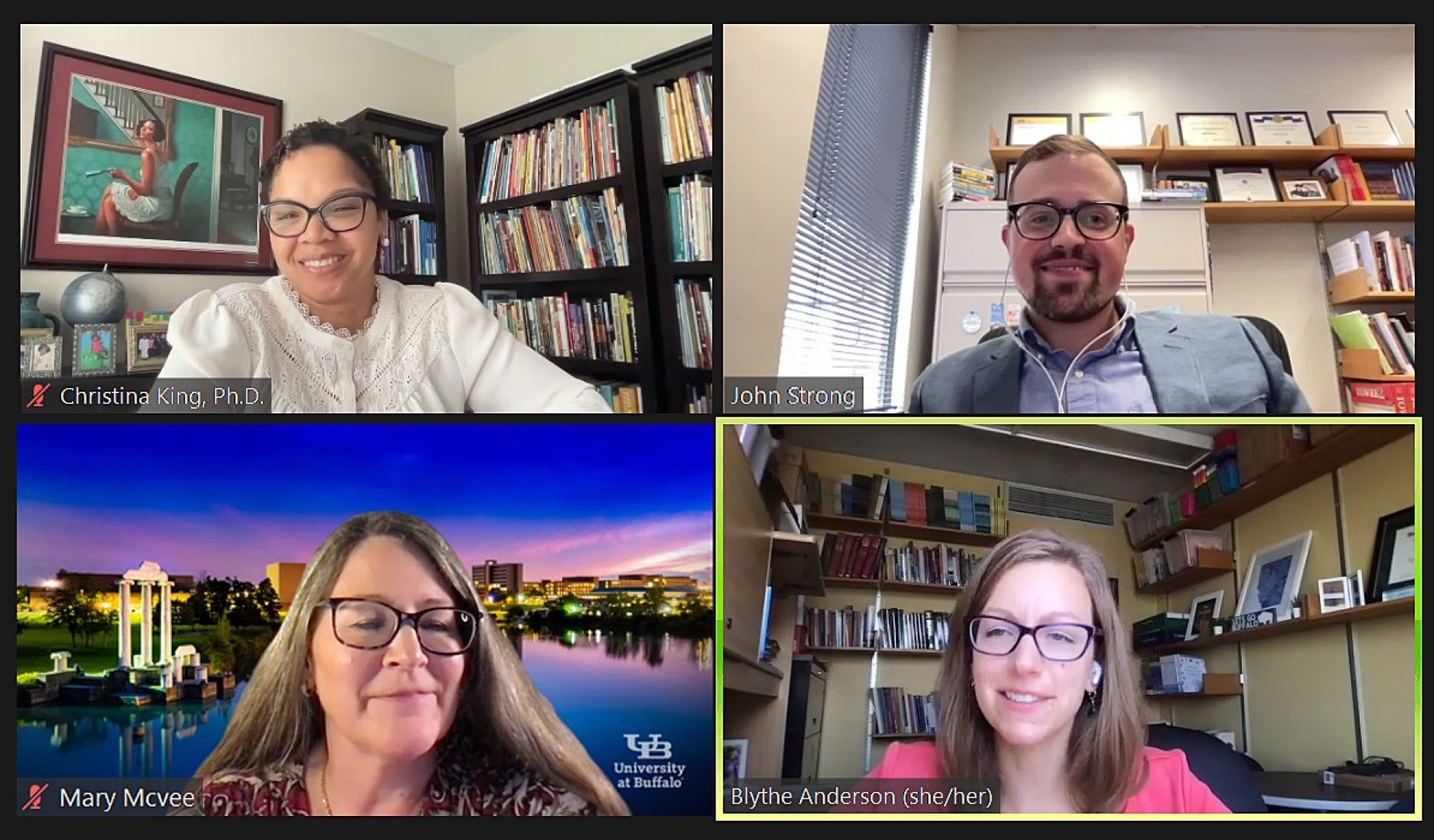
Published September 26, 2023
BY DANIELLE LEGARE
Going beyond the hashtag: GSE hosts “Things to Know about the Science of Reading” event
What is the “science of reading,” and why has it become a polarizing topic?
At a time marked by growing public concern about the number of school-aged children who have difficulties learning to read, GSE hosted the event, “Beyond the Hashtag: Ten Things to Know about the Science of Reading,” to explore and answer these questions.
With over 200 K-12 educators, parents, administrators, and UB students and alums registered, the virtual event, held on Sept. 7, shed light on the different perspectives and implications related to the “science of reading”—or, in other words, how children learn to read.
The presentation was moderated by Christina U. King, GSE clinical assistant professor of literacy education, and featured a panel of GSE’s literacy experts, including:
- Blythe Anderson, assistant professor of literacy education
- Mary McVee, professor of literacy education and director of GSE’s Center for Literacy and Reading Instruction
- John Strong, assistant professor of literacy education
McVee began the event by encouraging attendees to “think beyond the duality” of being either for or against the science of reading, and to instead consider the various positions and perspectives on the topic.
“We’ve been here before. Education and reading, in particular, have been subject to the pendulum swings in teaching and research … Reading instruction for children and youth is oftentimes presented as a duality, where there are dichotomous and sometimes irreconcilable positions,” said McVee. “For example, arguments are often—and especially this is true in the popular media and hashtags—presented as you are either for the science of reading or you are against the science of reading. And while those dualities are useful for hashtags or media influencers, they’re not particularly helpful to teachers, educational leaders, parents or children.”

Moderator Christina King (top left) and presenters John Strong (top right), Mary McVee (bottom left) and Blythe Anderson (bottom right). (Video captures: William Belz)
As the event progressed, the panelists clarified the meaning of the science of reading by sharing The International Literacy Association’s definition, which explains the term as “a corpus of objective investigation and accumulation of reliable evidence about how humans learn to read and how reading should be taught.”
Building off of this definition, Strong reported that this research encapsulates two different areas of scholarship. “We’re thinking about research investigating how humans learn to read—the developmental, cognitive, psychological and socio-cultural processes. [They’re] all related to how it is that we come to engage in this complex endeavor that is reading,” Strong said. “But also, importantly, it’s how reading should be taught, which is a different set of research.”
The presentation continued with the exploration of current issues and claims about reading instruction typical in the science of reading movement. Anderson offered a valuable reminder to the audience: “When we’re talking about science, I think it’s important to remember that science isn’t just a static set of knowledge... We continue to learn as we have more studies and more evidence, and so, while there are some practices that we feel pretty confident about because we have large bodies of evidence to support them, we’re always still learning.”
In addition to sharing evidence-based practices and resources focused on the science of reading, Anderson and Strong covered the core components of reading development and a range of theoretical models, including the simple view of reading, the active view of reading and the cognitive model of reading.
As the event name promised, the panelists also delivered ten key things—and two bonus items—to know about the science of reading, backed by decades of scientifically based reading research.
These need-to-know truths included:
- You don’t have to teach “advanced” phonemic awareness. “What the research is suggesting is that we really need to be able to work on phonemic awareness with letters involved. We want to get kids toward being able to use those letter-sound relationships in order to decode. So, spending a lot of time on this advanced phonemic awareness—just at the sound level, without including letters—is not really getting us toward that,” Anderson advised.
- Phonics must be explicit and systematic (with context to confirm). “We know from research that systematic, explicit phonics instruction is very effective. Recently, though, using context has gotten a bad rap… Correct, we do not want kids to be guessing at words based on pictures. But, that doesn’t mean that we don’t ever actually use context in order to read a word,” said Anderson, giving examples of words like “live” and “read.”
- There is a reciprocal relationship between skill and motivation. “It would be a shame to talk about the science of reading and not also talk about how motivation and engagement fit into a science of reading as well… I think that we often see that we’re either building a love of reading or we’re teaching skills. Actually, these things are related,” said Strong.
The event concluded with a robust Q&A with the audience.
“There’s more research to be done on the science of reading. We’re always growing, we’re always evolving, and we might change our thoughts about some of the things that we’ve said today. But I would just caution that maybe it’s a bit early to be legislating certain things that we need more evidence for, or that are maybe oversimplifications of this complex world of reading research that we have,” Strong said as the event came to a close.
Tuesday News Briefs feature the stories of the Graduate School of Education faculty, students and alumni who are engaged in their communities and making an impact through their hard work, dedication and research initiatives. If you have a story to share, please email us with the details for consideration as a future news feature.